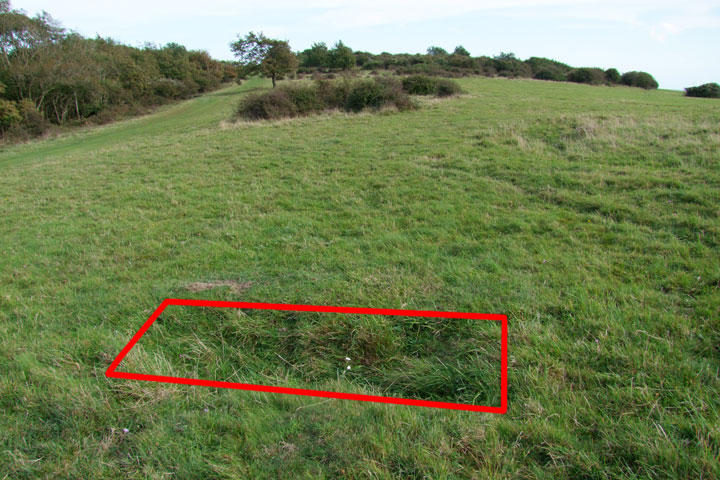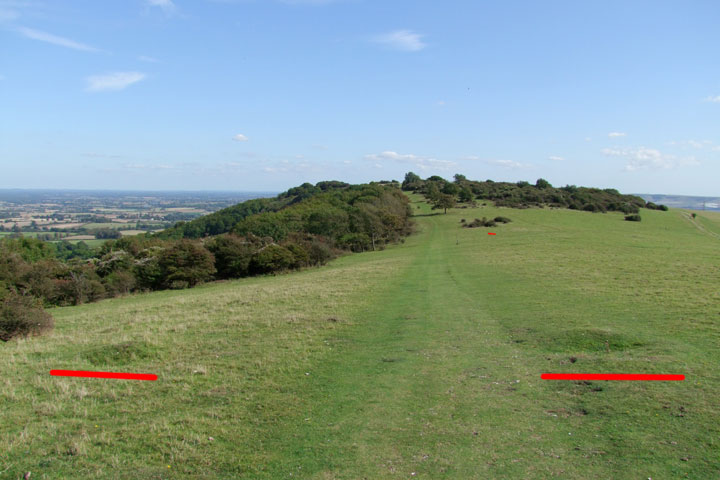A new Downs locality
Posted: 24 September 2009 18:42
I went up to a fresh area of the Downs to look for prepared positions and came away having identified 14 new slit trenches with at least another six possibles.
I'd not been to this area before, as, to be honest, I'm not entirely sure if it falls within my selected study boundaries. The boundary did extend in 1942, so I need to do some more research before I'm certain of this.
I was in the area only on the off-chance that trenches had been dug here; the hunch proved correct as I stumbled across this trench at a track junction at the bottom of a rising slope. The trench was clearly defined, still being about 30cm deep, although there was no trace of any corrugated iron or angle pickets.

Having found a series of six trenches here, I began to move up the slope and quickly found another brace; two trenches either side of the track. The photo below shows two of them, with the first trench marked in the distance.

The arrangement of these trenches is something I've not seen before; a line at the bottom of the slope, a line halfway up as well as a locality on the pinnacle of the slope (to the rear of those seen in the photo above.)
Although this system displays defence in depth, I would have expected to have found the trenches concentrated around the top of the slope, based on previous experience elsewhere on the Downs. I would certainly suggest that the lowest line of trenches does not cover a significant amount of ground that cannot be defended from higher up the slope.
In light of this (and currently a lack of documentary evidence) I'm tempted to fall back on the failsafe conclusion that these trenches were constructed for training purposes only, but I'm not convinced that such an assessment is as safe as it may seem.
With the exception of perhaps two areas (including today's find), every part of the Downs on which I've found WW2 earthworks is a documented battle position or associated with anti-invasion activity. I'm confident I can locate documents about today's area, while the other area is close to the location of a proposed underground battle HQ. I've walked many miles across the Downs and found no conclusive evidence of military activity in areas in which training was probably conducted but not associated with anti-invasion activity.
Of course, any such evidence as was there might have been ploughed out or is overgrown with dense gorse, but I have two points to raise here. Firstly, an order in the war diary of one Canadian Infantry Brigade to fill in any trenches (not just on the Downs) that are no longer in use, to prevent them being used by the enemy in the event of invasion. Secondly, documented evidence of the battle positions themselves being used in training exercises to drill the troops in the defence of their positions and presumably to give the attackers a feel for how that particular piece of landscape can be defended. It therefore follows that 'training trenches' and anti-invasion battle positions are one and the same.
I need to have another look at today's area, as I'm quite certain there are further trenches I've not yet located; the search in this locality was hampered by a large number of tumuli that seen from a distance are initially easily mistaken for much later earthworks.
The ease at which you can miss trenches was demonstrated on my return journey through a locality I'd already explored and recorded (or so I thought), when I walked into a set of three trenches arranged in all-round defence. I was too tired to stop and record them, but I know they're there next time I'm passing though.
- Pete

Email:
Blog Latest

Bishopstone reveals its pillbox secrets
18 October 2021

Pillbox or Observation Post?
10 June 2020

Uncovering the hidden secrets of a pillbox
8 June 2019

Review of 2018
31 December 2018

Wartime Christmas in East Sussex (2)
24 December 2018
Jargon-buster
Angle picket
Iron stake made in several lengths used for construction of barbed wire obstacles or to hold trench revetment in place.
Slit trench
Small, narrow trench designed to provide protection against shrapnel and other battlefield hazards. Technically distinct from a weapon pit (which was intended soley as a defensive position) slit trenches were also used as defence works.
War diary
A record of events kept by all units from the point of mobilisation. A diary's contents vary enormously from unit to unit; some give detailed entries by the hour on a daily basis while others merely summarise events on a weekly/monthly basis.
This site is copyright © Peter Hibbs 2006 - 2024. All rights reserved.
Hibbs, Peter A new Downs locality (2024) Available at: http://www.pillbox.org.uk/blog/216639/ Accessed: 25 April 2024
The information on this website is intended solely to describe the ongoing research activity of The Defence of East Sussex Project; it is not comprehensive or properly presented. It is therefore NOT suitable as a basis for producing derivative works or surveys!